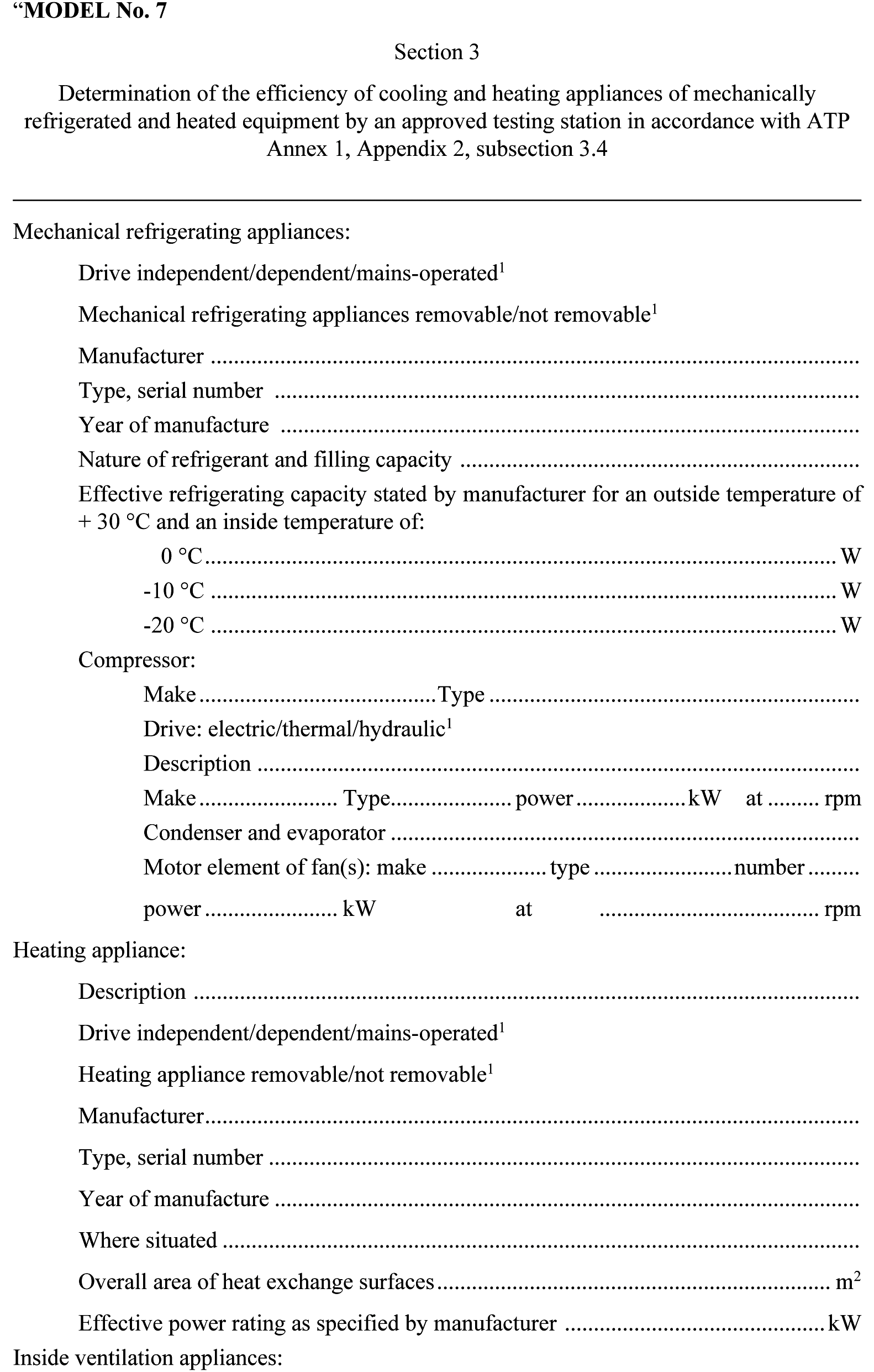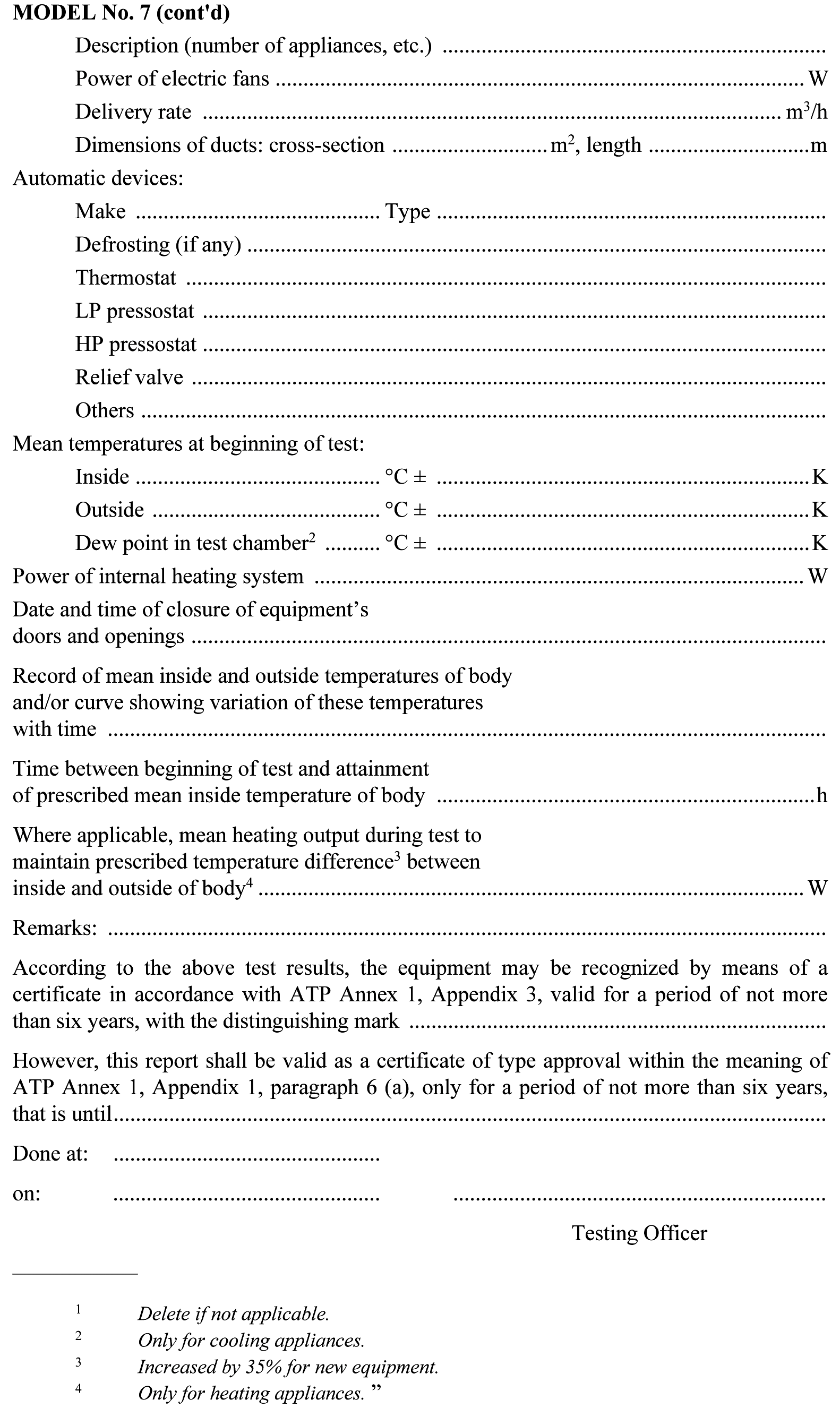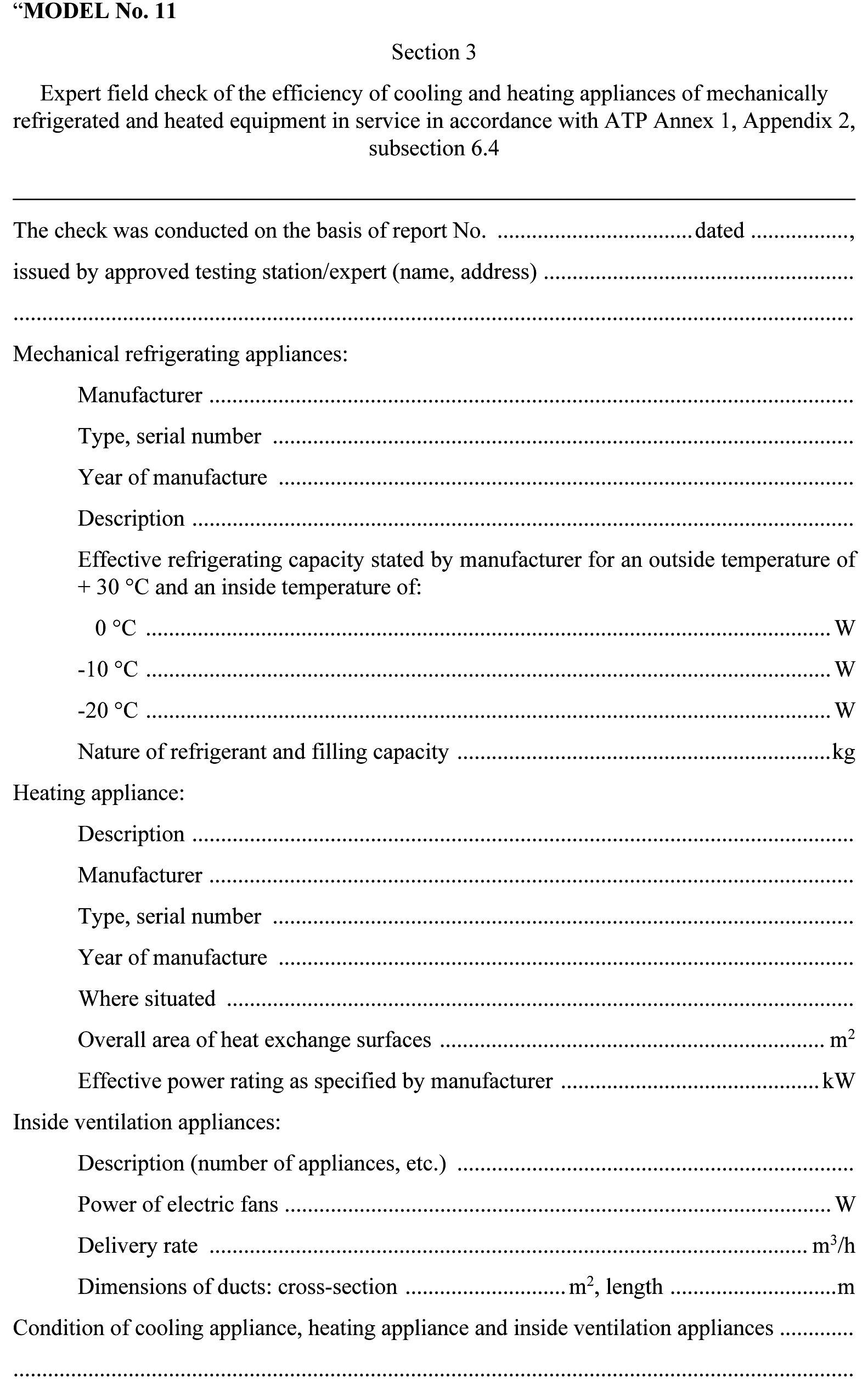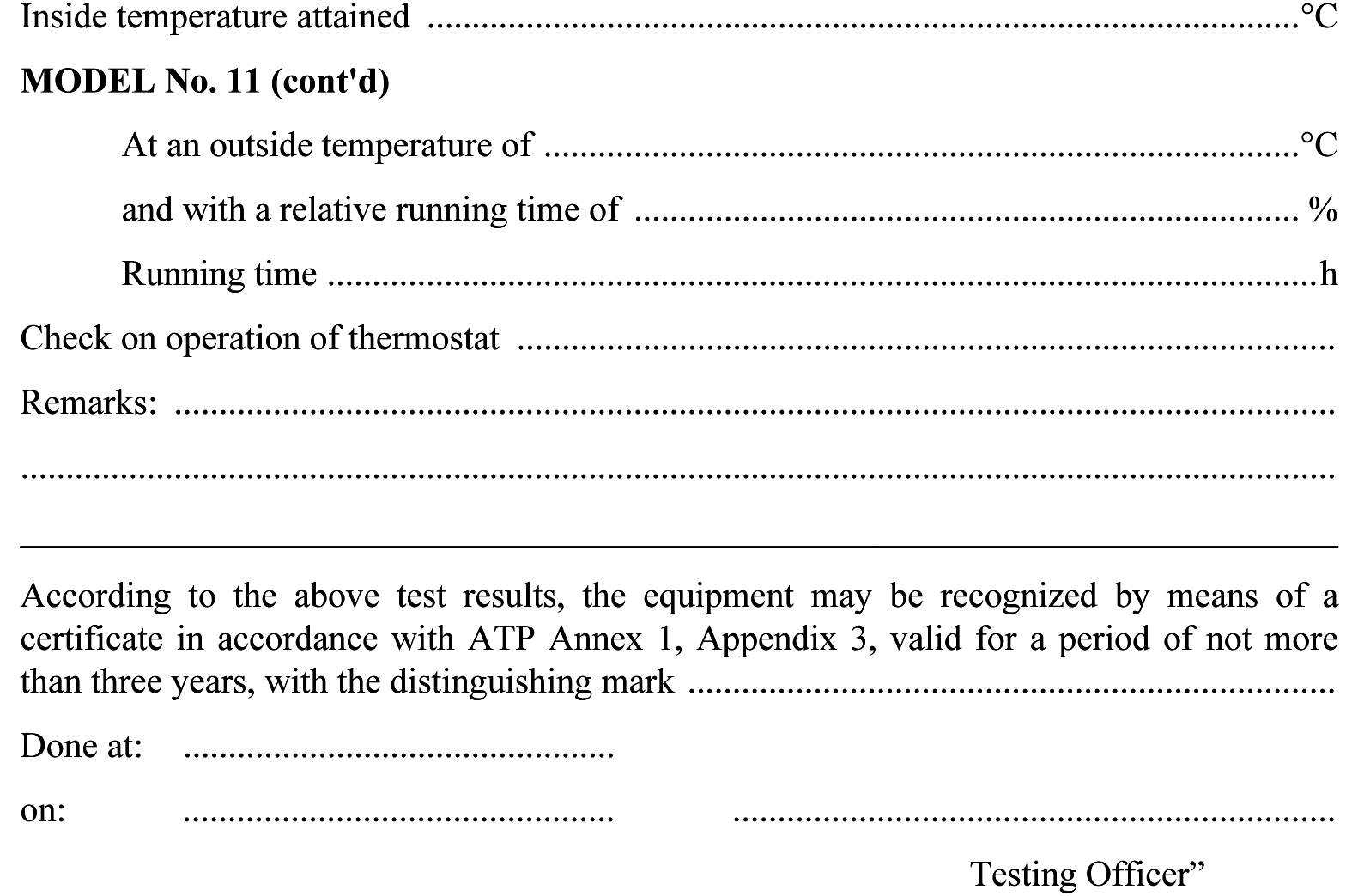Tractatenblad van het Koninkrijk der Nederlanden
| Datum publicatie | Organisatie | Jaargang en nummer | Rubriek | Datum totstandkoming |
|---|---|---|---|---|
| Ministerie van Buitenlandse Zaken | Tractatenblad 2016, 131 | Verdrag |
Zoals vergunningen, bouwplannen en lokale regelgeving.
Adressen en contactpersonen van overheidsorganisaties.
U bent hier:

| Datum publicatie | Organisatie | Jaargang en nummer | Rubriek | Datum totstandkoming |
|---|---|---|---|---|
| Ministerie van Buitenlandse Zaken | Tractatenblad 2016, 131 | Verdrag |
83 (1970) Nr. 30
Overeenkomst inzake het internationale vervoer van aan bederf onderhevige levensmiddelen en het gebruik van speciale vervoermiddelen bij dit vervoer (ATP) (met Bijlagen);
Genève, 1 september 1970
Voor een overzicht van de verdragsgegevens, zie verdragsnummers 002966 en 013365 in de Verdragenbank.
In Trb. 2009, 112, dient in de Engelse tekst de volgende correctie te worden aangebracht.
Op blz. 9 dient de titel van Bijlage 2, Aanhangsel 1, te worden vervangen door de volgende titel „Monitoring of air temperature for transport of quick-frozen perishable foodstuffs”.
In Trb. 2010, 325, dienen in de Engelse tekst de volgende correcties te worden aangebracht.
Op blz. 4, in Bijlage 1, Aanhangsel 1, bepaling 1 (b), dienen de woorden „periodically, at least once every six years;” te worden vervangen door „periodically, at least once every six years; and”.
Op blz. 19, in Bijlage 1, Aanhangsel 2, bepaling 4.3.2, laatste alinea, dient de zin „Appropriate methods are described in standards ISO 917, BS 3122, DIN, NEN, etc.” te worden geschrapt.
Op blz. 20, in Bijlage 1, Aanhangsel 2, bepaling 4.3.4 (ii), vijfde en zesde regel, dienen de woorden „i.e. BS 848, ISO 5801, AMCA 210-85, DIN 24163, NFE 36101, NF X10.102, DIN 4796 is recommended;” te worden vervangen door „i.e. ISO 5801: 2008, AMCA 210-99, AMCA 210-07 is recommended;”.
Op blz. 33, in Bijlage 1, Aanhangsel 2, Model No. 3, dienen de woorden „approved testing station expert (name and address) ” te worden vervangen door „ approved testing station/expert (name and address)”.
Op blz. 59, in Bijlage 1, Aanhangsel 3, in voetnoot nummer 10, tweede regel, dient „paragraph 3.2.7” te worden vervangen door „paragraph 3.2”.
In Trb. 2013, 71, dienen in de Engelse tekst de volgende correcties te worden aangebracht.
Op blz. 4, in Bijlage 1, Aanhangsel 2, bepaling 8.3.1, vierde alinea, tweede en derde regel, dienen de woorden „internal dividing and” te worden geschrapt.
Op blz. 5, in Bijlage 1, Aanhangsel 2, bepaling 8.3.2, derde liggend streepje, dienen de woorden „Sbody is the internal surface of the full body,” te worden vervangen door „Sbody is the geometric mean surface area of the full body,”.
Op 10 oktober 2014 heeft de Werkgroep voor het vervoer van aan bederf onderhevige levensmiddelen wijzigingen van artikel 1 van de Overeenkomst en enkele bepalingen van Bijlage 1 bij de Overeenkomst aangenomen. De Engelse tekst1) van de op 19 maart 2015 ter kennis gebrachte wijzigingen luidt als volgt:
Insert “rigid*” before “insulating walls…” and the following footnote:
“* Rigid in this case refers to non-flexible continuous or non-continuous surfaces, for example full solid walls or roller-shutter doors.”
Add a new paragraph 6 to read as follows:
“6. Transitional measures
6.1 Insulated bodies with non-rigid walls which first came into service before the amendment of paragraph 1 of annex 1 entered into force (date to be inserted) may continue to be used for the carriage of perishable foodstuffs of the appropriate classification until the validity of the certificate of compliance expires. The validity of the certificate shall not be extended. ”
[…]
Amend to read as follows:
“(ii) the rate of air circulation shall be measured using an existing standard.”
Amend to read as follows:
“For the international carriage of perishable foodstuffs, equipment shall not be designated as ‘insulated’, ‘refrigerated’, ‘mechanically refrigerated’, ‘heated’ or ‘mechanically refrigerated and heated’ equipment unless it complies with the definitions and standards set forth in annex 1 to this Agreement.”
Add the following new paragraph 5:
“5. Mechanically refrigerated and heated equipment. Insulated equipment either fitted with its own refrigerating appliance, or served jointly with other units of transport equipment by such an appliance (fitted with either a mechanical compressor, or an ‘absorption’ device, etc.), and heating (fitted with electric heaters, etc.) or refrigerating-heating units capable both of lowering the temperature Ti inside the empty body and thereafter maintaining it continuously, and of raising the temperature and thereafter maintaining it for not less than 12 hours without renewal of supply at a practically constant value, as indicated below.
Class A: Ti may be chosen between + 12 °C and 0 °C inclusive at a mean outside temperature between –10 °C and +30 °C.
Class B: Ti may be chosen between + 12 °C and 0 °C inclusive at a mean outside temperature between –20 °C and +30 °C.
Class C: Ti may be chosen between + 12 °C and 0 °C inclusive at a mean outside temperature between –30 °C and +30 °C.
Class D: Ti may be chosen between + 12 °C and 0 °C inclusive at a mean outside temperature between –40 °C and +30 °C.
Class E: Ti may be chosen between + 12 °C and –10 °C inclusive at a mean outside temperature between –10 °C and +30 °C.
Class F: Ti may be chosen between + 12 °C and –10 °C inclusive at a mean outside temperature between –20 °C and +30 °C.
Class G: Ti may be chosen between + 12 °C and –10 °C inclusive at a mean outside temperature between –30 °C and +30 °C.
Class H: Ti may be chosen between + 12 °C and –10 °C inclusive at a mean outside temperature between –40 °C and +30 °C.
Class I: Ti may be chosen between + 12 °C and –20 °C inclusive at a mean outside temperature between –10 °C and +30 °C.
Class J: Ti may be chosen between + 12 °C and –20 °C inclusive at a mean outside temperature between –20 °C and +30 °C.
Class K: Ti may be chosen between + 12 °C and –20 °C inclusive at a mean outside temperature between –30 °C and +30 °C.
Class L: Ti may be chosen between + 12 °C and –20 °C inclusive at a mean outside temperature between –40 °C and +30 °C.
The K coefficient of equipment of classes B, C, D, E, F, G, H, I, J, K and L shall in every case be equal to or less than 0.40 W/m2.K.
Heat producing or refrigerating-heating appliances when in heating mode shall have a capacity in conformity with the provisions of annex 1, appendix 2, paragraphs 3.4.1 to 3.4.5.”
Amend the title to read as follows:
“PROVISIONS RELATING TO THE CHECKING OF INSULATED, REFRIGERATED, MECHANICALLY REFRIGERATED, HEATED OR MECHANICALLY REFRIGERATED AND HEATED EQUIPMENT FOR COMPLIANCE WITH THE STANDARDS”.
Amend to read as follows:
“The insulated bodies of ‘insulated’, ‘refrigerated’, ‘mechanically refrigerated’, ‘heated’ or ‘mechanically refrigerated and heated’ transport equipment …” (remainder of text unchanged).
Amend to read as follows:
“If it is insulated equipment, in which case the reference equipment may be insulated, refrigerated, mechanically refrigerated, heated or mechanically refrigerated and heated equipment, ...” (remainder of text unchanged)
Add the following new text to read as follows:
“(v) If it is mechanically refrigerated and heated equipment, in which case the reference equipment shall be:
(a) mechanically refrigerated and heated equipment,
– the conditions set out under (i) above shall be satisfied;
and
– the effective refrigerating capacity of the mechanical refrigeration or mechanical refrigeration-heating appliance per unit of inside surface area, under the same temperature conditions, shall be greater or equal;
– the source of heat shall be identical; and
– the capacity of the heating appliance per unit of inside surface area shall be greater or equal;
or
(b) insulated equipment which is complete in every detail but minus its mechanical refrigeration, heating or mechanical refrigeration-heating appliance, which will be fitted at a later date.
The resulting aperture will be filled, during the measurement of the K coefficient, with close fitting panels of the same overall thickness and type of insulation as are fitted to the front wall, in which case:
– the conditions set out under (i) above shall be satisfied;
and
– the effective refrigerating capacity of the mechanical refrigeration or mechanical refrigeration-heating unit fitted to insulated reference equipment shall be as defined in annex 1, appendix 2, paragraph 3.4.7;
– the source of heat shall be identical; and
– the capacity of the heating appliance per unit of inside surface area shall be greater or equal.”
Add the following new subsection 3.4 to read as follows:
Test method
3.4.1 The test shall be carried out in two stages. The efficiency of the refrigeration unit of the refrigerating or refrigerating-heating appliance is determined in the first stage and that of the heating appliance is determined in the second stage.
3.4.2 In the first stage, the test shall be carried out in the conditions described in paragraphs 3.1.1 and 3.1.2 of this appendix; in the second stage, it shall be carried out in the conditions described in paragraphs 3.3.1 and 3.3.2 of this appendix.
Test procedure
3.4.3 The basic requirements for the test procedure for the first stage are described in paragraphs 3.2.2 and 3.2.3 of this appendix; those for the second stage are described in paragraphs 3.3.3 and 3.3.4 of this appendix.
3.4.4 The second stage of the test may be initiated immediately after the end of the first stage, without the measuring equipment being dismantled.
3.4.5 In each stage, the test shall be continued for 12 hours after:
(a) in the first stage, the mean inside temperature of the body has reached the lower limit prescribed for the class to which the equipment is presumed to belong;
(b) in the second stage, the difference between the mean inside temperature of the body and the mean outside temperature of the body has reached the level corresponding to the conditions prescribed for the class to which the equipment is presumed to belong. In the case of new equipment, the above temperature difference shall be increased by 35 per cent.
Criterion of satisfaction
3.4.6 The results of the test shall be deemed satisfactory if:
(a) in the first stage, the refrigerating or refrigerating-heating appliance is able to maintain the prescribed temperature conditions during the said 12-hour period, with any automatic defrosting of the refrigerating or refrigerating-heating unit not being taken into account;
(b) in the second stage, the heating appliance is able to maintain the prescribed temperature difference during the said 12-hour period.
3.4.7 If the refrigerating unit of the refrigerating or refrigerating-heating appliance with all its accessories has undergone separately, to the satisfaction of the competent authority, a test to determine its effective refrigerating capacity at the prescribed reference temperatures, the transport equipment may be accepted as having passed the first stage of the test without undergoing an efficiency test if the effective refrigerating capacity of the appliance in continuous operation exceeds the heat loss through the walls for the class under consideration, multiplied by the factor 1.75.
3.4.8 If the mechanically refrigerating unit of the refrigerating or refrigerating-heating appliance is replaced by a unit of a different type, the competent authority may:
(a) require the equipment to undergo the determinations and verifications for the first stage of testing prescribed in paragraphs 3.4.1–3.4.5 of this appendix; or
(b) satisfy itself that the effective refrigerating capacity of the new mechanically refrigerating unit is, at the temperature prescribed for equipment of the class concerned, at least equal to that of the unit replaced; or
(c) satisfy itself that the effective refrigerating capacity of the new mechanically refrigerating unit meets the requirements of paragraph 3.4.7 of this appendix.”
Amend to read as follows:
“To verify as prescribed in appendix 1, paragraphs 1 (b) and (c), to this annex the effectiveness of the thermal appliance of each item of refrigerated, mechanically refrigerated, heated or mechanically refrigerated and heated equipment in service, the competent authorities may:
Apply the methods described in sections 3.1, 3.2, 3.3 and 3.4 of this appendix; or
Appoint experts to apply the particulars described in sections 5.1 and 5.2 of this appendix, when applicable, as well as the following provisions.”
Insert the following new subsection 6.4 to read as follows:
The check is carried out in two stages.
(i) During the first stage, it shall be verified that, when the outside temperature is not lower than + 15 °C, the inside temperature of the empty equipment can be brought to the class temperature within a maximum period (in minutes), as prescribed in the table in paragraph 6.2 of this appendix.
The inside temperature of the empty equipment shall have been previously brought to the outside temperature.
(ii) In the second stage, it shall be verified that the difference between the inside temperature of the equipment and the outside temperature which governs the class to which the equipment belongs as prescribed in this annex (a difference of 22 K in the case of classes A, E and I, of 32 K in the case of classes B, F and J, of 42 K in the case of classes C, G and K, and of 52 K in the case of classes D, H, and L), can be achieved and maintained for not less than 12 hours.
If the results are acceptable, the equipment may be kept in service as mechanically refrigerated and heated equipment of its initial class for a further period of not more than three years. ”
Renumber current subsections 6.4 and 6.5 as 6.5 and 6.6, respectively.
Replace “or heated equipment” by “, heated, or mechanically refrigerated and heated equipment” (twice) and “3.1, 3.2 and 3.3” by “3.1, 3.2, 3.3 and 3.4” (twice).
Amend the text after the title to read as follows:
“A test report of the type appropriate to the equipment tested shall be drawn up for each test in conformity with one or other of the models 1 to 12 hereunder.”
Insert the following new Model No. 7 and renumber the current models accordingly:


Insert the following new Model No. 11 before existing Model No. 10 (new No. 12):


Amend the subtitle to read as follows: “FORM OF CERTIFICATE FOR INSULATED, REFRIGERATED, MECHANICALLY REFRIGERATED, HEATED OR MECHANICALLY REFRIGERATED AND HEATED EQUIPMENT USED FOR THE INTERNATIONAL CARRIAGE OF PERISHABLE FOODSTUFFS BY LAND”.
Insert the category “MECHANICALLY REFRIGERATED AND HEATED” in the heading row between “HEATED” and “MULTI-TEMPERATURE”.
Add the following new entries to the table:
|
“Equipment |
Distinguishing mark |
|---|---|
|
... |
... |
|
Class A mechanically refrigerated and heated equipment with normal insulation |
BNA |
|
Class A mechanically refrigerated and heated equipment with heavy insulation |
BRA |
|
Class B mechanically refrigerated and heated equipment with heavy insulation |
BRB |
|
Class C mechanically refrigerated and heated equipment with heavy insulation |
BRC |
|
Class D mechanically refrigerated and heated equipment with heavy insulation |
BRD |
|
Class E mechanically refrigerated and heated equipment with heavy insulation |
BRE |
|
Class F mechanically refrigerated and heated equipment with heavy insulation |
BRF |
|
Class G mechanically refrigerated and heated equipment with heavy insulation |
BRG |
|
Class H mechanically refrigerated and heated equipment with heavy insulation |
BRH |
|
Class I mechanically refrigerated and heated equipment with heavy insulation |
BRI |
|
Class J mechanically refrigerated and heated equipment with heavy insulation |
BRJ |
|
Class K mechanically refrigerated and heated equipment with heavy insulation |
BRK |
|
Class L mechanically refrigerated and heated equipment with heavy insulation |
BRL” |
Amend to read as follows:
“2. FOR MECHANICALLY REFRIGERATED EQUIPMENT AND MECHANICALLY REFRIGERATED AND HEATED EQUIPMENT:
2.1 Where the compressor is powered by the vehicle engine;
2.2 Where the refrigeration or refrigeration-heating unit itself or a part is removable, which would prevent its functioning.
…”
(remainder of text unchanged).
De vertaling van het gewijzigde artikel 1 luidt als volgt:
„In het internationaal vervoer van aan bederf onderhevige levensmiddelen mogen vervoermiddelen niet worden aangeduid als „geïsoleerde”, „niet-mechanisch gekoelde”, „mechanisch gekoelde”, „verwarmde” of „mechanisch gekoelde en verwarmde ” vervoermiddelen, tenzij zij beantwoorden aan de definities en normen vervat in Bijlage 1 bij deze Overeenkomst.”
De wijziging van 19 maart 2015 van de Bijlage bij de Overeenkomst behoeft ingevolge artikel 7, onderdeel f, van de Rijkswet goedkeuring en bekendmaking verdragen niet de goedkeuring van de Staten-Generaal.
De wijzigingen van 19 maart 2015 zullen ingevolge artikel 18, zesde lid, van de Overeenkomst op 19 december 2016 voor alle partijen, waaronder het Koninkrijk der Nederlanden, in werking treden.
Wat betreft het Koninkrijk der Nederlanden, geldt de wijziging, evenals de Overeenkomst, alleen voor Nederland (het Europese deel).
|
Land |
Voorlopige toepassing |
In werking |
Terugwerkende kracht |
Buiten werking |
|---|---|---|---|---|
|
Nederland (in Europa) |
30-11-1979 |
|||
|
Nederland (Bonaire) |
||||
|
Nederland (Sint Eustatius) |
||||
|
Nederland (Saba) |
||||
|
Aruba |
||||
|
Curaçao |
||||
|
Sint Maarten |
Uitgegeven de dertigste augustus 2016.
De Minister van Buitenlandse Zaken, A.G. KOENDERS
Finland heeft op 9 september 2015 conform artikel 18, tweede lid, sub a, van de Overeenkomst bezwaar gemaakt tegen deze wijziging. Conform artikel 18, vierde lid, van deze Overeenkomst is deze wijziging daarom niet aanvaard en zal deze niet gelden voor de partijen bij de Overeenkomst.
Kopieer de link naar uw clipboard
https://zoek.officielebekendmakingen.nl/trb-2016-131.html
De hier aangeboden pdf-bestanden van het Staatsblad, Staatscourant, Tractatenblad, provinciaal blad, gemeenteblad, waterschapsblad en blad gemeenschappelijke regeling vormen de formele bekendmakingen in de zin van de Bekendmakingswet en de Rijkswet goedkeuring en bekendmaking verdragen voor zover ze na 1 juli 2009 zijn uitgegeven. Voor pdf-publicaties van vóór deze datum geldt dat alleen de in papieren vorm uitgegeven bladen formele status hebben; de hier aangeboden elektronische versies daarvan worden bij wijze van service aangeboden.
